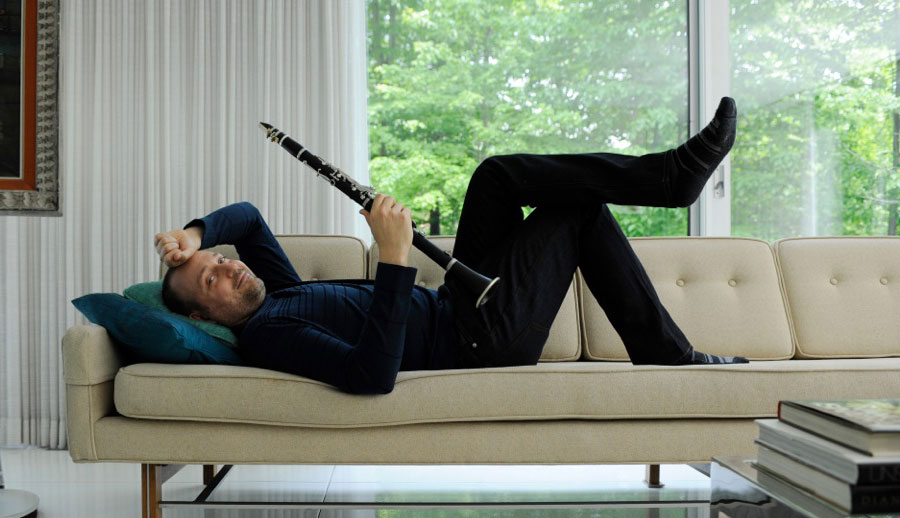Bermel, Bartók, Arensky: June 30, 2017
Derek Bermel returns once again to the Festival’s faculty, composing and performing on tonight’s eclectic program. His Death with Interruptions takes inspiration from writer José Saramago, dramatising Death as a musical character. Bartók’s compact and evocative Contrasts, composed for jazz clarinetist Benny Goodman, combines dances and melodies from across Central Europe. The second half brings a perennial favorite in the form of Arensky’s elegiac Piano Trio No. 1, inspired by the work of his friend and compatriot Tchaikovsky, whose own Piano Trio, composed a decade earlier, will be performed later in the season, on Friday, July 7.
DEREK BERMEL
Death with Interruptions
Derek Bermel has provided the following note to accompany Death with Interruptions:
Death with Interruptions is a piano trio, written in variation form. The title, which comes from the novel by the Portuguese writer José Saramago, describes the chaos that ensues when one day people mysteriously stop dying. Soon afterwards Death herself enters the narrative and falls madly in love with a cellist. I was intrigued by Saramago’s portrait of death as a character, viewed through a multitude of prisms: the mysterious, the impulsive, the ridiculous, and the dispassionate.
A simple melody begins the trio and it moves through a series of transformations in mood, texture, and speed. Variations continually return to the musical heartbeat present in the opening song. Through disparate textures and tempi, the obsessive rhythm emerges as a fixed element bridging musical landscapes. I began writing the work in the months following the passing of my father Albert Bermel, to whom it is dedicated; he was a playwright, a teacher, a translator, and a great lover of farce, who never seemed to believe that Death would visit one day.
bÉlA bARTÓK
Contrasts, Sz. 111
In 1938, Bartók received a letter from his U.S.-based compatriot, violinist Joseph Szigeti, conveying an enticing commission from famed clarinetist Benny Goodman. Goodman, despite his sensational career in jazz and swing, liked to keep a foot in the world of “classical” music (later in his career, he would commission a concerto from Aaron Copland, and record chamber works by Beethoven, Brahms, Weber, and others). Szigeti, on the other hand, was a lifelong friend of Bartók’s; Bartók had first composed for him in 1928 (Rhapsody No. 1); and in the 1940s Szigeti would spearhead fundraising efforts to support Bartók, whose health and spirits suffered after he had been forced to emigrate from Hungary to the U.S. during World War Two.
The new composition requested by Goodman and Szigeti was to comprise two short movements in Hungarian styles to fit onto the two sides of a 78 record (i.e., approximately three minutes each). The musical material ballooned, however; two movements became three, and each twice as long. The first movement, “Verbunkos,” takes its name after a Hungarian style of dance derived from military recruiting rituals – also a favorite style of Liszt’s. The second movement, “Pihenő” (usually translated as “relaxation”), is exemplary of Bartók’s “night music” style, capturing a mysterious atmosphere inspired by the rustlings of the natural world, birds and insects in particular. In the final movement, “Sebes” (“fast”), Bartók calls for an unconventional violin tuning, a technique called scordatura; the dissonant new tuning is brazenly displayed in the movement’s opening double-stops, setting off a feverish thematic whirlwind.
ANTON ARENSKY
Piano Trio No. 1 in D Minor, Op. 32
Anton Arensky was born to a musical family in Novgorod, Russia, a city situated on the axis between St. Petersburg and Moscow. Arensky showed compositional promise in his youth, and when his family moved to St. Petersburg, he studied at the conservatory there with Rimsky-Korsakov. Upon graduating in 1882, he immediately became professor of harmony and counterpoint at the Moscow Conservatory, where his students included Scriabin and Rachmaninoff. He remained there until 1895 and returned to St. Petersburg to direct the Imperial Choir until his retirement in 1901, whereupon he dedicated himself to composition and touring as a pianist and conductor. Arensky died from tuberculosis at the early age of 45, by which time his life had become increasingly disorderly due to drinking and gambling addictions.
With Arensky’s move from St. Petersburg to Moscow came a shift in his stylistic inclinations: away from the Russian nationalism espoused by his former teacher, and toward Tchaikovsky’s pan-European embrace. The influence of Tchaikovsky is particularly obvious in Arensky’s Piano Trio No. 1. The opening of the first movement – a dramatic, soaring theme in the middle register introduced by the strings in turn – recalls that of Tchaikovsky’s own Piano Trio, completed a decade earlier, and which will be performed at the Festival on July 7. The trio bears a dedication to Karl Davydov, considered by many the greatest Russian cellist of the nineteenth century, who had died suddenly in 1889; the third movement, titled “Elegia,” is Arensky’s poignant memorial.

